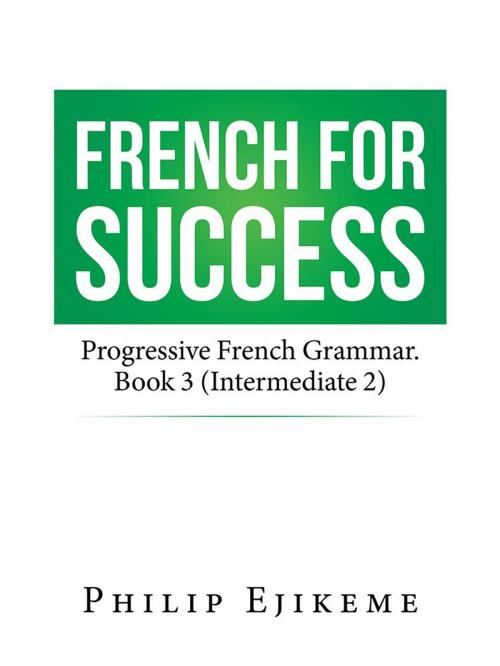French for Success
Progressive French Grammar. Book 3 (Intermediate 2)
Nonfiction, Reference & Language, French Language| Author: | Philip Ejikeme | ISBN: | 9781524629281 |
| Publisher: | AuthorHouse UK | Publication: | December 8, 2016 |
| Imprint: | AuthorHouse UK | Language: | English |
| Author: | Philip Ejikeme |
| ISBN: | 9781524629281 |
| Publisher: | AuthorHouse UK |
| Publication: | December 8, 2016 |
| Imprint: | AuthorHouse UK |
| Language: | English |
French for Success is conceived to facilitate the mastery of the French grammar rules. Conjugation of verbs, which used to be a hard nut to crack, can now be mastered in a day or two. Verbs are placed into categories, rather than groups, according to their patterns of conjugation. A category, therefore, is a group of verbs that share similar patterns of conjugation in all tenses. In a given category or group, the radical is used only once, instead of six, to facilitate memorization. And in any given group, what applies to one verb in a given tense applies to every single verb. Although there are over four thousand verbs in category 1A, it takes only a few minutes to master their conjugations. This is because conjugation is merely a substitution of radicals. Corresponding verb endings do not change. Even some irregular verbs share this concept of common-radical conjugation. They include those ones that have two stems or radicals. The conjugation shortcuts exposed in these manuals will help minimize spelling errors. But the curious might wonder why we prefer categories to groups. The reason is simple. Currently, there are three main groupsfirst, second, and third groups. However, within each group, there are multiple subgroups, which do not necessarily share the same patterns of conjugation at all. In the first group alone, there are seventeen subgroups. We reduce those seventeen groups to eight; group B comprises verbs ending in ir, such as finir and agir. But there are countless other verbs in ir that do not share the same conjugations as finir and agir. Partir, sortir, and mentir share a pattern of conjugation that is different from finir and agir. Courir and its compound verbs have a totally different pattern of conjugation. So do many other groups of verbs ending in ir. In the same vein, group 3 contains, among other groups of verbs, attendre, prendre, coudre, moudre, etc., with each group having a conjugation pattern entirely different from the others, although they all end in re. Therefore, our definition of category is a group of verbs that have mutually substitutable radicals and mutually interchangeable endings in a given tense. Aim-, parl-, cout-, and donn- can replace one another, but they cannot replace cd-, accd-, etc., although these verbs are said to belong the premier group and end in er. Themes are selected to facilitate visual identification. Thus, adjectives of the same form are grouped together both according to the gender and number. It becomes easier to distinguish masculine from feminine or the singular form from the plural. The manuals are divided into four books for the progressive acquisition of the rules of French grammar. Comparative forms are continued in book 3. Also treated in this volume are present and past perfect tenses, direct and indirect objects, negation, and interrogative mood. Students learn to form nouns from verbs, and the contexts in which those nouns are used. Finally, indirect speech, synonyms, antonyms, suffixes, and prefixes are examined.
French for Success is conceived to facilitate the mastery of the French grammar rules. Conjugation of verbs, which used to be a hard nut to crack, can now be mastered in a day or two. Verbs are placed into categories, rather than groups, according to their patterns of conjugation. A category, therefore, is a group of verbs that share similar patterns of conjugation in all tenses. In a given category or group, the radical is used only once, instead of six, to facilitate memorization. And in any given group, what applies to one verb in a given tense applies to every single verb. Although there are over four thousand verbs in category 1A, it takes only a few minutes to master their conjugations. This is because conjugation is merely a substitution of radicals. Corresponding verb endings do not change. Even some irregular verbs share this concept of common-radical conjugation. They include those ones that have two stems or radicals. The conjugation shortcuts exposed in these manuals will help minimize spelling errors. But the curious might wonder why we prefer categories to groups. The reason is simple. Currently, there are three main groupsfirst, second, and third groups. However, within each group, there are multiple subgroups, which do not necessarily share the same patterns of conjugation at all. In the first group alone, there are seventeen subgroups. We reduce those seventeen groups to eight; group B comprises verbs ending in ir, such as finir and agir. But there are countless other verbs in ir that do not share the same conjugations as finir and agir. Partir, sortir, and mentir share a pattern of conjugation that is different from finir and agir. Courir and its compound verbs have a totally different pattern of conjugation. So do many other groups of verbs ending in ir. In the same vein, group 3 contains, among other groups of verbs, attendre, prendre, coudre, moudre, etc., with each group having a conjugation pattern entirely different from the others, although they all end in re. Therefore, our definition of category is a group of verbs that have mutually substitutable radicals and mutually interchangeable endings in a given tense. Aim-, parl-, cout-, and donn- can replace one another, but they cannot replace cd-, accd-, etc., although these verbs are said to belong the premier group and end in er. Themes are selected to facilitate visual identification. Thus, adjectives of the same form are grouped together both according to the gender and number. It becomes easier to distinguish masculine from feminine or the singular form from the plural. The manuals are divided into four books for the progressive acquisition of the rules of French grammar. Comparative forms are continued in book 3. Also treated in this volume are present and past perfect tenses, direct and indirect objects, negation, and interrogative mood. Students learn to form nouns from verbs, and the contexts in which those nouns are used. Finally, indirect speech, synonyms, antonyms, suffixes, and prefixes are examined.















